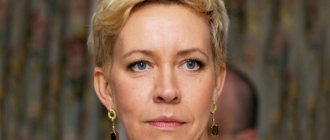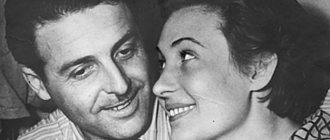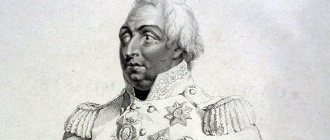Military service, continued studies, baptism
After studying for a year, Abramov was called up for compulsory military service in the Soviet Army. In 1982, in the city of Yelets, he studied at the sergeants school for six months. After graduation, he was sent to serve in the Arctic, on the Kola Peninsula. Having spent the required two years in the ranks of the SA, he was demobilized, having risen to the rank of “senior sergeant”.
Returning home, Mikhail continued his studies, from 1985, at the same faculty, but preferred evening studies.
During the same period, Mikhail Yuryevich Abramov makes a fateful decision for himself - he converts to the Orthodox faith, having accepted the rite of baptism.
The childhood and youth of Mikhail Abramov
Mikhail Abramov was born in October 1963 in Moscow into a family of doctors.
Misha's parents were not rich and, like all Soviet citizens, people indifferent to religion. Misha grew up like most Soviet children without faith in God and unbaptized. The boy visited Orthodox churches and synagogue more out of curiosity than at the behest of his soul. Video course “Spring”
Landscaping for busy people, a beautiful garden without the hassle
A training course for those who want to make their dacha beautiful and prefer to spend their time, effort and money wisely.
Special offer! 50% discount! Make good use of your self-isolation!
₽ 1200.00 ₽ 600.00
MORE ❯❯❯
As Abramov likes to remember, he was of free religion. Misha passed on his passion for collecting icons from his stepfather, with whom the boy grew up. My stepfather was an intelligent man, a doctor of physical and mathematical sciences, and a teacher. He had valuable icons in his house. Intelligence was in my stepfather’s blood, since his ancestors were factory owners and educated people versed in art.
Businessman Mikhail Abramov is the founder of the Museum of Russian Icons. Mikhail Abramov’s school years were spent at Moscow School No. 232, which he successfully graduated from in 1981. In the same year, the young man entered the Faculty of Chemical Technology of the Institute of Light Industry.
After studying for a year at a Moscow university, Mikhail left in 1982 for Yelets to serve in the Soviet army. In Yelets, a young soldier studies at a sergeant's school, after which he continues to serve on the Kola Peninsula in the Arctic. After graduating from service with the rank of Senior Sergeant in 1984, Mikhail returned to Moscow and continued his studies at the university in the evening department of the same faculty. At this time, another important event occurred that left its mark on his future fate. Mikhail Abramov converts to Orthodoxy and undergoes baptism.
Start of business and activity, career achievements
Taking into account the fact that Mikhail studied in the evening, the rest of the time he was engaged in entrepreneurial activities. Since 1985, taking advantage of the “Perestroika” period, he has created a number of cooperatives that are engaged in sewing fur and leather products.
He was engaged in this activity until the early nineties of the 20th century.
In 1991, he found a new application for himself - he went to work for the Moscow Insurance Company, and began working there in structures involved in the construction of structures in the capital and the Moscow region.
In it, he quickly and successfully begins to move up the career ladder, becoming the first deputy general director in 2000.
Hobby: collecting icons
Talking about this activity, Mikhail Yuryevich Abramov reports that in the process of fulfilling his official duties, ensuring the construction and sale (sale, rental) of residential buildings, office premises, cottages, up to entire villages in the Moscow region, he managed to collect ( accumulate) a substantial amount of money.
This led Mikhail Abramov to think about where to invest the collected funds. In 2003, he decided that the best option would be to purchase and collect icons. In the same year, Mikhail Yuryevich buys the first hundred images.
According to Mikhail Yuryevich Abramov, it follows that his interest in icons began to manifest itself from childhood. His stepfather, a teacher, doctor of sciences, a very educated intellectual, kept several valuable and ancient icons. He was originally from Siberia. His ancestors were wealthy factory owners. They were educated people, philanthropists, well versed in art. Mikhail’s stepfather told about their history, and also talked about the icons that he inherited.
Since 2003, since the purchase of ancient icons, Mikhail Abramov has begun to understand them. Study in detail the history of icon painting in Rus' and Orthodoxy in general. Famous scientists and specialists from Moscow and St. Petersburg are gradually being involved in the process of collecting and systematizing acquired icons. They assist him in creating displays and organizing exhibitions.
Talking about his hobby, in a number of interviews, Mikhail Yuryevich Abramov says that he is confident in the spiritual power of images of saints. He believes that icons have had and continue to influence the historical path of Russia.
Abramov acquires them all over the world, entering into negotiations with owners of private collections, and participating in auctions abroad. All purchased icons are sent to Russia. Mikhail Yuryevich is confident that the process of returning them to their homeland is his fateful mission.
Museum
In 2006, Mikhail Yuryevich Abramov came to the conclusion that the collected icons should be shown to people. He creates a private museum.
The Museum of Russian Icons of Mikhail Abramov is located in the center of Moscow, next to the Taganskaya metro station (arrow of the Moscow River and the Yauza River).
Currently, museum exhibitions number almost 5,000 items, of which about 1,000 are icons. The museum exists solely at the expense of the founder, Mikhail Yuryevich Abramov.
The museum does not carry out any commercial activities. Visiting it and excursions are free.
The basis of the museum collection is Russian icons from the 14th to 20th centuries. The museum also has collections of handwritten books and unique decorative and applied items. Thematic exhibitions dedicated to late antique and early Christian monuments are presented; Byzantine applied art; Greek icon painting; Christian Ethiopian art.
Guardian of Russian Heritage: Eternal Memory of Mikhail Abramov
Mikhail Abramov. Photo: Vitaly Belousov /TASS
It's scary to imagine. Sunny hot August. Greece. Quiet Aegean Sea. A small helicopter flies quite low in the sky. Suddenly... the car hits power lines, the pilot loses control, and the helicopter falls into the sea. Two Russian passengers and a Greek pilot die. Among the dead is 55-year-old businessman Mikhail Abramov.
The name of this man rarely appeared on federal channels and the pages of leading newspapers, but he was known not only in business circles. And not so much himself, but the main business of his life, not at all what brought him income, but, on the contrary, forced him to spend a fair amount. This business is an old Russian tradition of philanthropy, which brought Russia famous merchant names of the 19th and early 20th centuries. Among the Ryabushinskys and Morozovs, the Tretyakovs and Mamontovs, the Bakhrushins and Khludovs and many other Russian philanthropists of the past, a new name has appeared: Abramov.
A man born in a time far from widespread interest in Russian spiritual culture, he became one of those who, at the beginning of the 21st century, did no less, and in some ways even more, to preserve it than the entire Russian State represented by the Ministry of Culture and others departments and state museums. One of many private collectors of Russian icons, of which there were many in Soviet times, Mikhail Abramov did not keep these shrines at home, constructing massive iconostases on the walls of his bedrooms and kitchens. Instead, he created a private Museum of Russian Icons, making his private collection open and absolutely free for millions of both true connoisseurs and those who are just taking the first steps towards the spiritual traditions of their ancestors.
Born in 1963 into a Soviet family of Moscow doctors, Mikhail Abramov himself was quite far from the Church and faith until almost 40 years of age. But everyone has their own path to the temple, and for Mikhail Yuryevich it was directly connected with the icon. As the creator of the Moscow cult club “Mayak”, member of the Russian Artistic Union, actress and screenwriter Larisa Bravitskaya, who knew Abramov well, told the Tsargrad TV channel:
In the 1990s, Misha visited us at Mayak very often, lively and active, he loved to communicate with people of culture: artists, musicians, journalists. Representatives of business also often came to us, but they behaved very modestly and never became arrogant. In those years, nothing spoke of his interest in Orthodoxy, but around 2000 a turning point occurred. Misha was immediately struck. This was due to the desire to find an ancient icon of his Heavenly patron Archangel Michael, and having found it, he began to look for an icon for his son Gaucher - St. George the Victorious. And through this I came to faith.
Probably, many who have wandered the crooked alleys of Taganka in recent years have seen a museum complex consisting of two restored pre-revolutionary apartment buildings and a modern glass atrium.
Moscow. The building of the private Museum of Russian Icons. Photo: Gavriil Grigorov/TASS
It is here, under the guise of the “Museum of Russian Icons”, that the personal collection of Mikhail Abramov is located, consisting of several thousand exhibits, including truly unique Byzantine, Old Russian, Old Believer and other Eastern Christian (including the rarest and extremely interesting Ethiopian) church objects art.
Unlike many other collectors, Abramov perfectly understood and repeatedly said this that he was not the owner, but only a temporary custodian of this Christian heritage. Repeating that his goal is to make it public, to provide an opportunity to preserve, study and show modern people what our ancestors have created for centuries. And on the way to this goal, he constantly strived to expand the public museum he created, to turn it into a genuine center of ancient Russian art (the best art historians and restorers worked at the Museum of Russian Icons).
So, in one of his interviews he clarified:
Why did I want to make a museum from the very beginning? Because I don’t know how my children and grandchildren will manage the collection and whether it will be of interest to them at all. And while it is interesting to me, I want to make my collection public. So that everyone knows: in Moscow, on Goncharnaya Street, there is the Museum of Russian Icons. I often repeat that we, like the previous owners, are just temporary custodians of the icons. Temporary!
Visitors at the opening of the exhibition "Icon" Murom Wonderworkers, with the Life of Peter and Fevronia" 1669. Blessed Princes and Righteous Wives" as part of the series "Masterpieces of Ancient Russian Painting from the Collections of Russian Museums" in the private Museum of Russian Icons. Photo: Gavriil Grigorov/TASS
Realizing this, Mikhail Abramov perfectly understood the temporary nature of our earthly life itself. And so I hurried to do as much as possible. I managed to do a lot. Another attempt to expand the collection (knowledgeable people write: “flying for the icon”) ended tragically. As always, we do not know God’s Providence, why He allowed this tragedy to happen. One can boldly assume that “there” He needs such people more.
But of course, the question inevitably arises: what about the case of Mikhail Abramov? Will anyone be able to continue it? Will it be possible to preserve the Moscow Museum of Russian Icons, to which Mikhail Yuryevich devoted himself entirely? Abramov’s friends and colleagues are asking these questions. Thus, in an interview with the Tsargrad TV channel, collector Alexander Lipnitsky noted that this requires government support:
If he did not make a special will that some percentage of his capital will go to the maintenance of the museum, then only government intervention can save this museum from its completely natural sale. The heirs simply will not be able to maintain this museum.
I would like to hope that the authorities of the Russian State realize the importance of the loss that the entire Russian culture suffered with the passing of Mikhail Abramov. And his work, to which he dedicated the last one and a half decades of his bright and eventful life, will be continued. And, of course, I would like to offer condolences to all the relatives, friends and co-workers of Mikhail Yuryevich.
In the blessed dormition, grant eternal peace, O Lord, to Your departed servant Michael and create for him eternal memory!
Businessman
According to official data obtained from the media, it follows that Mikhail Yuryevich Abramov is the founder of companies in Moscow, namely, Art-Alliance AK LLC, Museum of Russian Icon, Bonorg LLC, Persvet Info LLC , Viland LLC.
He is also the owner of the construction company Plaza Development.
Currently, this structure is carrying out work to commission a number of structures in Moscow. Among them are businesses (near the Nagatinskaya metro station), the building of the Vereyskaya Plaza business district.
At the end of 2020, information appeared that the Moscow City Hall filed claims against Plaza Development in connection with the illegal construction of the West Park business center (Ochakovskoe Highway). From the published information it follows that the developer carried out the construction illegally, without obtaining the appropriate permits. Moscow authorities intend to legally recognize West Park as self-development and carry out its demolition.
About the Museum of Russian Icons
Wikipedia reports that the Abramov Museum is the first private museum of Russian icons in Moscow and the second in Russia. The status of the museum is confirmed by the international museum organization ICOM and the Union of Museums of Russia. The institution existed solely at the expense of Abramov and was free to visit.
Abramov’s goal was not only to introduce his compatriots to the Russian school of icon painting, but also to return to Russia those icons that, for various reasons, ended up in other countries. To do this, he participated in auctions, bought from private collectors, and the like.
The museum's collection contains about 5,000 exhibits, including about 1,000 icons painted before the 20th century. The cost of the collection is estimated at hundreds of thousands of dollars; the maintenance of the museum cost the patron tens of thousands of US dollars per month.
In 2020, Abramov was awarded a UNESCO medal for his contribution to the preservation of historical heritage, and was an honorary member of the Russian Academy of Arts. In addition to museum activities, he was actively involved in charity work: helping veterans and orphanages, building churches and improving the city.
Mozilla/5.0 (Windows NT 6.3; Win64; x64) AppleWebKit/537.36 (KHTML, like Gecko) Chrome/81.0.4044.122 Safari/537.36 [2a01:4f8:162:224::2]
Abramov's personal life
Sergei Yuryevich Abramov, according to him, mainly lives in his house near Moscow, in the Nikolina Gora cottage village (Rublevo-Uspenskoe highway, Odintsovo district, Moscow region), which he calls a dacha.
Once a week he visits the nearby Savvino-Storozhevsky Monastery, but does not consider himself overly religious.
Mikhail’s wife, Svetlana, has been with her husband for many years. They met while studying together at the Institute of Light Industry. They have two children, a son and a daughter.
Brief biography of Mikhail Abramov
Mikhail Abramov is a Muscovite, he was 55 years old (born October 12, 1963). His parents are doctors, but he did not follow in their footsteps: in 1981 he entered the Institute of Light Industry (now the Kosygin Russian State University), then served in the army, and since 1985 he went into business, opening several cooperatives for sewing leather and fur products.
In 1991, he moved to Ingosstrakh, where he rose to the post of deputy general director. Then (after 2000) he went into construction business (his company built several large business centers in Moscow). From that time on, Abramov became interested in icon painting and began collecting objects of ancient Russian and Byzantine art. In 2006, he opened the Museum of Russian Icons, where he donated his private collection and made it available to everyone.











